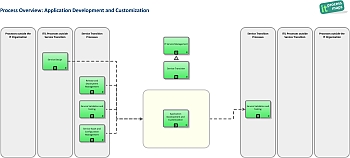Application Development and Customization: Difference between revisions
No edit summary |
mNo edit summary |
||
| Line 1: | Line 1: | ||
<imagemap> | |||
Image:ITIL-Wiki-de-es.jpg|ITIL Application Development and Customization|100px | |||
rect 0 0 50 30 [https://wiki.de.it-processmaps.com/index.php/Anwendungsentwicklung_und_Customizing diese Seite auf Deutsch] | |||
rect 50 0 100 30 [https://wiki.es.it-processmaps.com/index.php/Desarrollo_y_Personalizacion_de_Aplicaciones esta página en español] | |||
desc none | |||
</imagemap> | |||
<br style="clear:both;"/> | |||
== ITIL Application Development and Customization: Overview == | |||
'''Process Objective''': To make available applications and systems which provide the required functionality for IT services. This process includes the development and maintenance of custom applications as well as the customization of products from software vendors. | '''Process Objective''': To make available applications and systems which provide the required functionality for IT services. This process includes the development and maintenance of custom applications as well as the customization of products from software vendors. | ||
| Line 10: | Line 13: | ||
'''Part of''': [[ITIL V3 Service Transition|Service Transition]] | '''Part of''': [[ITIL V3 Service Transition|Service Transition]] | ||
'''Process Owner''': [[ | '''Process Owner''': [[Application Development and Customization#Additional Information on Application Development and Customization|Application Developer]] | ||
==ITIL | == ITIL Application Development and Customization: Process Definition == | ||
<imagemap> | |||
Image:overview_application_development_customization_itilv3_thumb.jpg|left|ITIL Application Development and Customization|350px|thumb | |||
default [https://wiki.en.it-processmaps.com/images/pdf/process_overview_application_development_customization_itilv3.pdf Application Development and Customization ITIL (.pdf)] | |||
desc bottom-left | |||
</imagemap> | |||
Application Development is barely mentioned in the ITIL V3 books, as ITIL V3 focuses on different topics like service design and rollout. At IT Process Maps we decided to eliminate that gap by introducing an Application Management process which takes care of the actual application coding and the customization of standard software packages | |||
Even if ITIL Application Management is generally regarded a field of its own, we think an Application Management process must be included in any ITIL V3 process structure to make sure that there are clearly defined interfaces between the design, development and rollout stages of a service. | |||
* Note: ITIL does not provide a detailed explanation of all aspects of Application Development. Rather, it highlights the most important activities and assists in identifying interfaces with other Service Management processes. | |||
No sub-processes are specified for [[Application Development and Customization|Application Development and Customization in compliance with ITIL V3]]. | |||
<br style="clear:both;"/> | |||
== ITIL Terms: Application Development and Customization == | |||
;<span id="End-User Documentation">End-User Documentation</span> | |||
:A document for end-users, describing how to use an application or system. | |||
;<span id="Operational Documentation">Operational Documentation</span> | |||
:A document describing the procedures required to run and maintain an application or infrastructure component. | |||
== Additional Information on Application Development and Customization == | |||
==== ITIL Roles ==== | |||
;Application Developer - Process Owner | |||
:A role responsible for ensuring that a process is fit for purpose. The Process Owner’s responsibilities include sponsorship, design, and continual improvement of the process and its metrics. | |||
:This role is often assigned to staff holding one of the major Service Management roles (e.g. the Incident Manager is the Process Owner of the Incident Management process). | |||
<!-- This page is assigned to the following categories: --> | |||
[[Category:ITIL V3]][[Category:ITIL process]][[Category:Service Transition|Application Development & Customization]][[Category:Application Development & Customization|!]] | |||
<!-- --- --> | |||
Revision as of 09:42, 12 April 2010

ITIL Application Development and Customization: Overview
Process Objective: To make available applications and systems which provide the required functionality for IT services. This process includes the development and maintenance of custom applications as well as the customization of products from software vendors.
Part of: Service Transition
Process Owner: Application Developer
ITIL Application Development and Customization: Process Definition

Application Development is barely mentioned in the ITIL V3 books, as ITIL V3 focuses on different topics like service design and rollout. At IT Process Maps we decided to eliminate that gap by introducing an Application Management process which takes care of the actual application coding and the customization of standard software packages
Even if ITIL Application Management is generally regarded a field of its own, we think an Application Management process must be included in any ITIL V3 process structure to make sure that there are clearly defined interfaces between the design, development and rollout stages of a service.
- Note: ITIL does not provide a detailed explanation of all aspects of Application Development. Rather, it highlights the most important activities and assists in identifying interfaces with other Service Management processes.
No sub-processes are specified for Application Development and Customization in compliance with ITIL V3.
ITIL Terms: Application Development and Customization
- End-User Documentation
- A document for end-users, describing how to use an application or system.
- Operational Documentation
- A document describing the procedures required to run and maintain an application or infrastructure component.
Additional Information on Application Development and Customization
ITIL Roles
- Application Developer - Process Owner
- A role responsible for ensuring that a process is fit for purpose. The Process Owner’s responsibilities include sponsorship, design, and continual improvement of the process and its metrics.
- This role is often assigned to staff holding one of the major Service Management roles (e.g. the Incident Manager is the Process Owner of the Incident Management process).






